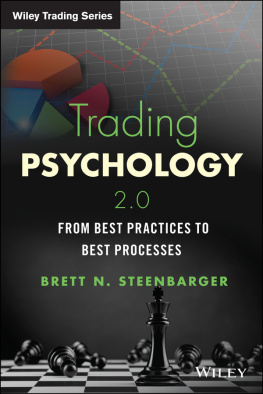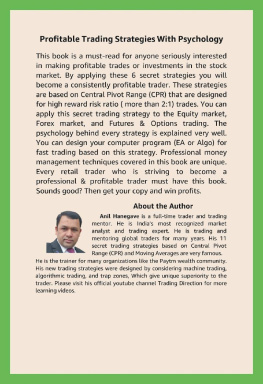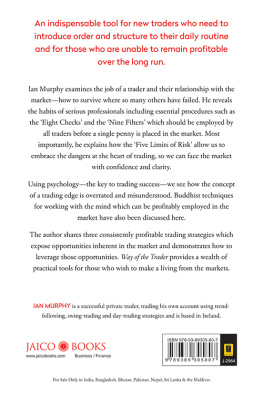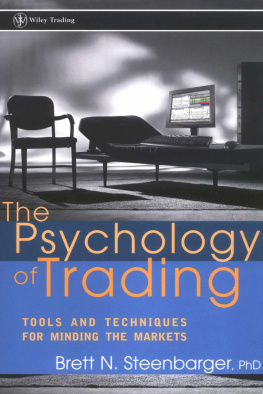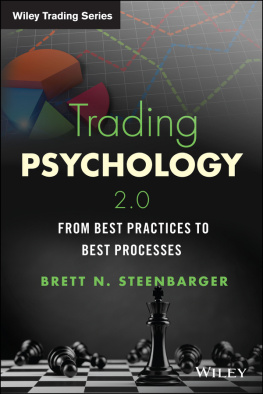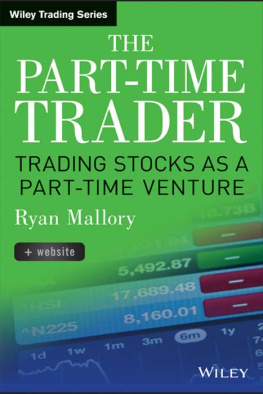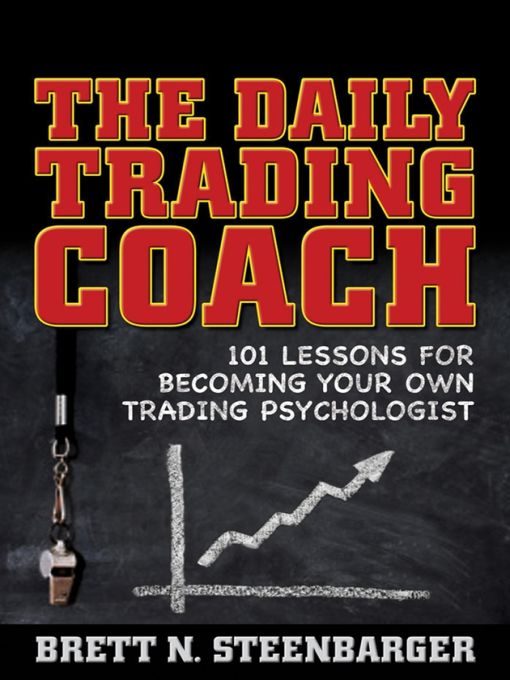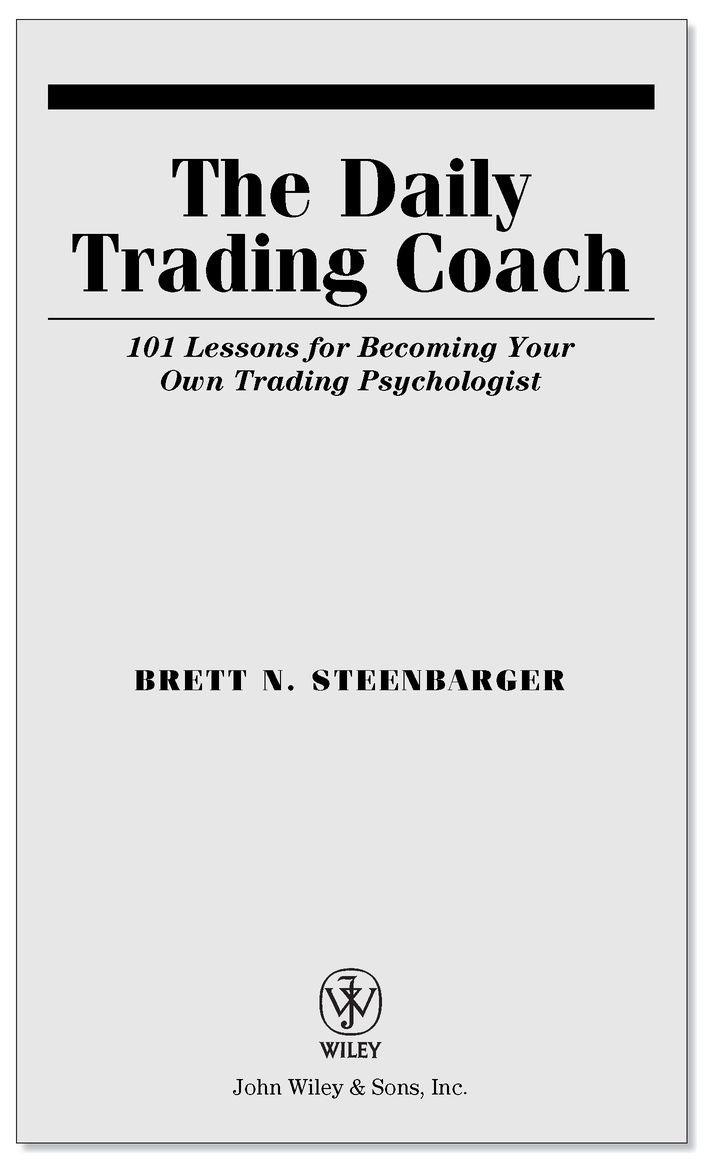Table of Contents
Founded in 1807, John Wiley & Sons is the oldest independent publishing company in the United States. With offices in North America, Europe, Australia and Asia, Wiley is globally committed to developing and marketing print and electronic products and services for our customers professional and personal knowledge and understanding.
The Wiley Trading series features books by traders who have survived the markets ever changing temperament and have prosperedsome by reinventing systems, others by getting back to basics. Whether a novice trader, professional or somewhere in-between, these books will provide the advice and strategies needed to prosper today and well into the future.
For a list of available titles, visit our Web site at www.WileyFinance.com.
What? A great man? I always see merely
the play-actor of his own ideal.
Friedrich Nietzsche
Preface
The goal of The Daily Trading Coach is to teach you as muchasp ossible about coaching, so that you can mentor yourself to success in the financial markets. The key word in the title is Daily. This book is designed to be a resource that you can use every day to build upon strengths and overcome weaknesses.
After writing two booksThe Psychology of Trading and Enhancing Trader Performanceand penning more than 1,800 posts for the TraderFeed blog (www.traderfeed.blogspot.com/), I thought I had pretty well covered the terrain of trading psychology. Now, just three years after the publication of the performance book, Ive once again taken electronic pen to paper, completing a trading psychology trilogy by focusing on the process of coaching.
Two realities led to The Daily Trading Coach. First, a review of the traffic patterns on the TraderFeed blog revealed that a large number of readersabout a thirdwere accessing the site during the hour or so immediately prior to the market open. I found this interesting, as most of the posts do not offer specific trading advice. Rather, posts deal with topics of psychology and performanceones that should be relevant at any hour of the day.
When I asked a group of trusted readers about this pattern, they responded that they were using the blog as a kind of surrogate trading coach. Reviewing the posts was their way of reminding themselves of their plans and intentions before going entering the financial battlefield. This was confirmed when I gathered statistics about the most popular (and commented upon) posts on the blog. The majority were practical posts dealing with trading psychology. Most were uplifting in content, even as they challenged the assumptions of readers. It seemed as though traders were looking for coaching and finding some measure of it in the blog.
The second reality shaping this book involves digital publication and the rapid changes sweeping the publishing world. To this point, relatively few electronic books (e-books) have been offered to traders. When those books are available, they are little more than screen versions of the print text. Despite the allure and convenience of electronic publishing, few traders I consulted actually sought out or used e-books. The most common complaint among traders was that they did not want to spend hours devouring information in front of a screen after a full day of trading. I quickly realized that participants in the financial markets dont use the electronic medium in the same way that they engage print text. That led me to think about writing a different kind of book, one better suited to publishings electronic frontier, but also useable in print.
When you overlay these two observations, you can appreciate the vision that led to this text: a trading coach in a book that can be as easily read on the screen as on paper. The goal was to integrate blog and book content by creating practical lessons that help traders become their own trading coaches. There are 101 lessons in The Daily Trading Coach, averaging several pages in length. Each lesson follows a general format, identifying a trading challenge, an approach to meeting that challenge, and a specific suggestion or assignment for working on the issue. The chapters are independent of one another: you can read them in order, or you can use the table of contents or index to read, each day, the lesson that most applies to your current trading. Unlike a traditional book, the idea is not to read it through from front to back in a few sittings. Rather, you take one lesson at a time and apply it to guide your development as a trader. Like the blog, its an on-screen reminder of what to do when youre at your best, butmore than the blogits also a roadmap (and practical set of insights and tools) for discovering and implementing the best within you.
My ambition has been to pack into these 101 lessons more useable information and practical methods than might be found in any number of expensive seminars and coaching sessions, at far less expense. Too often, the goal of the seminar providers and coaches is to convert you into ongoing clients. The intent of this book is just the opposite: to give you the tools to become your own coach, so that you can guide your own professional and personal growth. In other words, this is a manual of psychoeducation: a how-to guide for improving yourself and your performance.
One thing I particularly like about the electronic format is that it enables a writer to link the book content to a vast array of material on the Web. I will be adding material to The Daily Trading Coach via a dedicated blog called Become Your Own Trading Coach (www.becomeyourowntradingcoach.blogspot.com), so that this book will grow over time. You will need only to click the e-book links to access free updated information and methods on the Become Your Own Trading Coach site. There is one master page on the blog for each chapter of this book containing the links relevant to that chapters material. At the end of each chapter, there is also a resource page that alerts readers to further links and readings. I will be adding audio and video content to the new blog over time, which should be particularly helpful for those who learn best by seeing and hearing ideas. Once publishing becomes electronic, theres no reason that every text cant be a multimedia learning experience.
Youll notice from the table of contents that each of the 10 chapters contains 10 lessons. Those chapters cover a range of topics relevant to trading psychology and trading performance, including specific lessons for utilizing psychodynamic, cognitive, and behavioral brief therapy methods to change problematic behavior patterns and instill new, positive ones. The final two chapters are especially unique: Chapter 9 consists of self-coaching perspectives from 18 successful trading professionals who share their work online. Chapter 10 fulfills a long-standing promise to TraderFeed readers, walking traders through the basics of identifying historical patterns using Excel. Each lesson is accompanied by homework activities and suggestions (Coaching Cues) to help with application of the ideas. Major ideas are set apart within the text for quick review and scanning. At the end of each chapter is a list of resources to guide your further inquiry into the books topics and ideas.
Yes, the aim of the book is to help you become your own trading coach, but a glance at the chapter and lesson titles reveals that the broader purpose is to help you coach yourself through life. The challenges and uncertainties we face in tradingthe pursuit of rewards in the face of risksare just as present in careers and relationships as in markets. Techniques that help you master yourself as a trader will serve you well in any field of endeavor.


